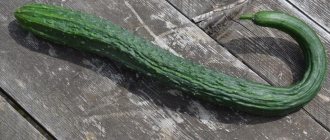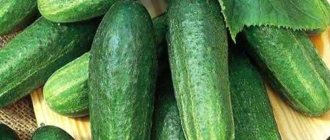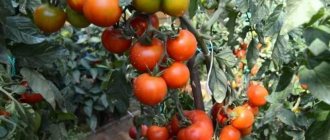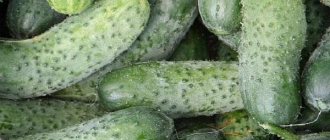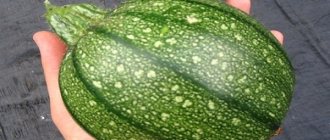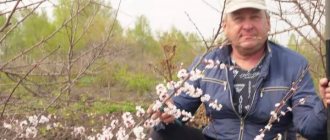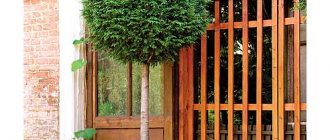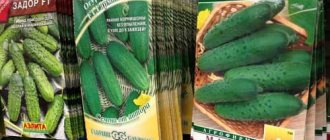Bee-pollinated cucumbers are familiar to all gardeners without exception, and despite the emergence of new parthenocarpic hybrids, they are still popular. They are grown in open ground and greenhouses and used to prepare all kinds of preparations. New hybrid forms with improved characteristics have been developed, but the favorites are still the good old varieties, from which the most delicious pickles and marinades are obtained. When choosing a variety, it is necessary to take into account the recommendations given in the descriptions, some secrets of cultivation, and then the harvest will definitely be abundant.
Bee-pollinated cucumbers: advantages and disadvantages of the crop
Insect-pollinated cucumbers are nothing new. Such plants have been grown in our temperate continental climate for many years. Recently, new varieties have been developed that make it possible to harvest vegetables at the earliest possible date. Typically, early ripening cucumbers begin to bear fruit after 40-45 days. The fruits have a delicate peel, white thorns, juicy pulp, size - 10-12 centimeters.
Many early cucumbers are salad cucumbers; their length differs from ordinary ones - they are slightly oblong (about 27 centimeters).
True, some early varieties have thicker skin, dark thorns, they can be eaten fresh and used for pickling.
Medium or late varieties of cucumbers come in different lengths. Tiny gherkins grow up to 5-9 centimeters. Hybrid varieties are distinguished by a bunched ovary, the length of the fruit is 9-12 centimeters. Such crops give a large harvest. However, cucumbers with similar qualities cannot be grown from the seeds of their fruits. Vegetables ripen only after 50-60 days. Basically, all late crops are grown for preservation or pickling.
Pros of insect-pollinated varieties:
- excellent taste characteristics;
- disease resistance;
- cold resistance;
- good yield under favorable weather conditions;
- seed can be obtained.
Minuses:
- dependence on the presence of insects;
- in the sun, with little watering, cucumbers become bitter;
- Yields may be reduced due to unfavorable weather conditions.
It is recommended to plant early, mid and late varieties in the garden. In this case, it will be possible to harvest throughout the season. Gardeners need to know that there are two types of cucumbers. Some grow on low bushes that you don’t have to deal with. Others form tall stems that need constant care. First, remove the side stepsons, form a stem, and at the end, pinch the top.
Crops with long stems need support; they are usually allowed to climb along a trellis. Bee-pollinated cucumbers are usually planted in an open bed. Although it can be planted in a film greenhouse or greenhouse. It is advisable that the plant be completely open to insects at the time of flowering.
Important rules for forming cucumbers
At the top, near the ceiling of the greenhouse, there should not be much thickening, otherwise the cucumbers will not bear fruit due to lack of light. On a horizontal section of the stem that grows along the trellis, it is necessary to remove some of the stepsons and lower the remaining ones down. You can also trim individual leaves to let in more light.
You can begin to shape cucumbers only after they take root after transplantation and begin to grow.
Any pruning should be done in the first half of the day in dry, clear weather so that the cuts heal faster.
When cutting the stepsons, you need to leave a small “stump” 5 mm long in their place. It is desirable that the shoots themselves by this time are no more than 5–7 cm.
Despite the variety of different patterns, the formation of cucumbers comes down to pinching all the stepsons after one or three leaves. If this is done on time, the plants will use their strength and nutrients in the best possible way, and the gardener will receive the maximum harvest.
Which cucumbers are better: bee-pollinated or self-pollinated?
It happens that due to rainy, cool weather or a small number of insects, all cucumber flowers are not pollinated, that is, pollen from male flowers does not fall on female ones. The ovaries are not fully formed, which reduces the yield. However, breeders have come up with new hybrid crops—parthenocarpic cucumbers.
Only female flowers grow on plants, and ovaries are formed without pollination. Typically, such crops are planted in greenhouses.
There is another type of cucumber - self-pollinating. They have pistils and stamens in one flower, that is, the process of pollination occurs when pollen from the stamens enters the pistil. The plant pollinates itself, without involving any insects in this process. Subsequently, fruits with seeds inside are formed. Self-pollinating crops are usually grown in film greenhouses, on balconies and even on window sills.
If we compare the taste qualities of different types of cucumbers, then those that are pollinated by insects are better. They are crispy, juicy, not bitter, with a pleasant cucumber aroma. However, self-pollinating varieties have higher yields. After all, ovaries are formed regardless of the presence of insects or weather conditions.
Reviews
Galina, 57 years old
“I cultivate several varieties in my garden. One of them is bee pollinated. Under favorable weather conditions, I get even more yield from it than from parthenocarpics. I like the intense aroma and richer taste. However, to make sure that no matter the weather, I won’t be left without cucumbers, I also plant self-pollinating hybrids.”
Ivan, 42 years old
“For sales, I grow cucumbers in a greenhouse so that I can harvest them earlier. Honey baits help attract bees and bumblebees for pollination. As a result, the ovary is formed intensively, the harvest is rich and of high quality. The fruits have a pronounced cucumber aroma, which increases the price of greens at the end of spring, when ground vegetables are not yet on the shelves.”
Bee-pollinated cucumbers can produce a rich and stable harvest in different agroclimatic zones. The main thing is to be able to attract insects for pollination, and then regularly care for the bushes.
Growing and care in a greenhouse
Insect-pollinated crops can be grown in a greenhouse, but it will be difficult to lure bees there. It is advisable to open windows and doors wider at the time of flowering or completely remove the film covering.
When to sow and plant seedlings
From the moment of sowing the seeds to transferring the seedlings to the garden bed, 20-25 days should pass. Then the plant will develop for another 20 or 30 days. If you sow the seeds in early May, then by the end of this month you can plant the seedlings in the greenhouse, and in June you can harvest the crop.
It is not advisable to sow fresh seeds. The seed must sit for at least two years. Before sowing, the seeds are heated or hardened at low temperatures, then, for disinfection, they are soaked for 20 minutes in a pink solution of potassium permanganate.
The growing seedlings are initially kept in a heated room, and at the stage of 4 true leaves they are transferred to the greenhouse.
Cucumbers do not like picking or root breaks. It is advisable to immediately plant the seedlings in peat cups.
See also
Why are there a lot of barren flowers on cucumbers and what to do?
Read
Seating Charts
The seedlings are transplanted into pre-dug holes. Planting scheme: cucumbers are planted in rows, each row can have two furrows. The crops are planted opposite each other, at a distance of 50 centimeters. There should be at least 40 centimeters to the neighboring bush. It is advisable to leave a gap of 80 centimeters between the rows.
What crops can be planted with cucumbers?
It is advisable to grow each crop separately. However, in the neighboring bed you can plant Chinese cabbage, turnips, mustard, peppers, and eggplants. The best option is dill. This plant, thanks to its aroma, will repel pests from cucumbers. Along with cucumbers, you can plant green beans. It doesn't take up too much space. Cucumbers and beans need the same amount of watering. It is not recommended to plant tomatoes and potatoes near cucumbers.
Is it possible to plant self-pollinating and bee-pollinated crops together?
Several types of cucumbers can be planted in one greenhouse, but preferably at a distance of 80 centimeters from each other. Crops of the same variety can be planted in adjacent beds, in the same row. Self-pollinating plants will produce crops regardless of the presence of insects. Crops pollinated by bees will form ovaries if their flowers are pollinated by bees, flies, and bumblebees.
Frequency of watering and fertilization
Immediately after transplantation, the seedlings are watered regularly (every 2 days). Water consumption is 2-3 liters per 1 square meter. At the moment of ovary formation and fruiting, the amount of moisture is almost doubled. Watering is carried out in the evening. If it is too hot during the day, then after 16 hours the bushes can be irrigated with water. During intense heat, this procedure is not recommended - the leaves can quickly burn in the sun.
Water for irrigation is taken warm, not hard, and settled. It is advisable to collect rainwater in barrels or canisters and water the cucumbers with it.
During the development period, cucumbers need additional feeding. Organics and minerals are added to the soil even before seedlings are planted. Two weeks after transplanting the seedlings, they are fed with mullein or nitrogen fertilizers. Take a liter of mullein solution or 30 grams of nitroammophoska per bucket of water.
During the flowering period, the following feeding is done: for 10 liters of liquid, take 30 grams of potassium sulfate, superphosphate, and urea. During fruiting, the bushes are fed as follows: take 0.5 liters of mullein or 30 grams of nitroammophosphate and potassium sulfate per bucket of water.
Forming cucumbers
For bee-pollinated varieties, a frequent problem is the formation of empty flowers, when only male flowers appear on the bush. In this case, the main stem is pinched. This procedure stimulates the development of side shoots on which ovaries are formed. The crop will bear fruit better if stepsoning is carried out. Remove the side shoots formed at the nodes of the lashes, while leaving the ovaries that appear
How to pollinate in greenhouse conditions
In closed structures, problems with pollination of flowers often arise. Even through windows and doors that are wide open, insects are reluctant to fly. You can help crops and pollinate flowers using a soft paint brush.
Male and female flowers grow on the same stem. The female ones have a small ovary under the flower. Using a brush, pollen is collected from male flowers and transferred to female flowers. You can pick a male flower, tear off the leaves and use the stamen to pollinate the pistils of female flowers.
Parthenocarpic cucumbers
Modern parthenocarpic hybrids were bred specifically for greenhouses or closed greenhouses, where bees do not fly. These varieties do not require pollination. There are no male inflorescences here, only female ones, which are initially already pollinated. You just need to create suitable conditions for the growth of cucumbers.
Advantages:
- High yield. Modern varieties have high yields. From one square meter per season, several buckets of fruit are collected. This is not a fairy tale, but reality.
- Easy to care for. Parthenocarpics, do not require pollination. You just need to plant the seeds in the greenhouse and then carry out regular watering, as well as form a bush. And you will always have a harvest.
- Harvest at any time of the year. Parthenocarpic hybrids grow well even in spring or winter, with a lack of sunlight. It is only enough to provide the plants in the greenhouse with warmth and nutrition. As mentioned earlier, they do not need pollination.
Flaws:
- Taste qualities. If we compare hybrids with old bee-pollinated varieties, they are inferior in taste. Especially when salted. Old varieties of cucumbers are crispier when pickled.
- Difficulty collecting seeds. Modern hybrids do not retain varietal qualities. Therefore, when collecting seeds, there is no guarantee that the exact same cucumbers will grow next year.
Planting and caring for plants in open ground
Cucumber seedlings are planted in the garden at the end of May. If the air has warmed up to 15-18 degrees Celsius, there is no danger of night frosts, and the soil temperature is 10 degrees, then young plants can be transferred as early as mid-May. The seedlings are first hardened, that is, gradually accustomed to the new environment. At the end of May or at the beginning of June, you can immediately sow the seeds in the garden. True, the crop will begin to bear fruit only in July. But the bushes will grow more viable.
Before planting cucumbers, the soil needs to be prepared: dug, fertilized, loosened. A bucket of rotted humus and 30 grams of nitrogen, potassium and phosphorus fertilizers are added per 1 square meter of plot. Cucumbers prefer non-acidic soil. It is advisable to add another 500 grams of wood ash or dolomite flour. Before planting, the holes can be disinfected with a pink solution of potassium permanganate.
When choosing a place for cucumbers, it is advisable to take into account some nuances: bushes in direct sunlight quickly wither. Vegetables can be planted in partial shade or near tall crops (sunflowers, green beans). You cannot plant cucumbers in a bed where tomatoes and potatoes used to grow. Predecessors can be onions, carrots, radishes.
Cucumbers planted in the garden are watered regularly. For irrigation, use settled, warm water. About 4 liters of water are poured under each bush at a time. True, you can’t pour water under the root. Water the plants every 2 days, more often in hot weather, and stop watering in cool, rainy weather. When the plants bloom and begin to form ovaries, the water consumption is doubled. At the time of fruiting, the bushes also need more moisture.
See also
How to make a net for cucumbers with your own hands and installation rules
Read
2 weeks after planting, the plants are fertilized with organic matter or nitrogen fertilizers. At the time of flowering, potassium and phosphorus supplements are added. When fruiting begins, the bushes are fed with nitrogen and potassium substances. Usually, for 10 liters of water, take 30 grams of any fertilizer or 1 liter of mullein.
Bushes need to be constantly looked after. Loosen the soil and remove weeds. Tall stems are tied to a support. You constantly need to ensure that the bushes are not too dense and to shape them. The side shoots are removed, leaving only the ovaries; the top, after the formation of the 11th leaf, is pinched.
To combat diseases, biological preparations or fungicides are used. For prevention, plants are irrigated with a solution of Bordeaux mixture. If cucumbers do not form ovaries well, spray with a solution of boric acid.
Preventive spraying with a solution of potassium permanganate or copper sulfate helps against all diseases. To control pests, infusions of tobacco, wood ash, onions, garlic, and a solution of laundry soap are used.
How to pinch parthenocarpic hybrids
Parthenocarpics form ovaries, often bundled, on the main stem. Everyone knows how much joy the first flower with an ovary brings on a small cucumber only 30–40 cm high. We boast, admire, and concentrate all our attention on this cucumber in anticipation of the first harvest. But now the whip has grown more than a meter, and the cucumber is still in one pore. And suddenly we unexpectedly discover the first ripe cucumber in a completely different place, much higher on the stem.
No matter how happy you are about the first ovaries, cucumbers will first grow in another part of the plant
It turns out that the ovaries in the lower sinuses grow twice as slow as those at a distance of 70–100 cm from the root. Therefore, start shaping when there are only 5-6 true leaves on the plant. Remove from the axils of the lower 4–5 all ovaries with flowers and emerging side shoots, if any. This event will take the load off the young plant, all the energy will go towards growing roots and then a strong stem. The harvest will be earlier and richer. If it’s a pity to remove the first ovaries, or you have doubts, then conduct an experiment. On two or three plants, remove everything from the lower axils, grow the rest of the cucumbers as usual. Compare the power and productivity of bushes from different groups. Of course, the cucumbers must be of the same variety and age.
Video: how to remove ovaries from the axils of the lower leaves
But the formation does not end there. The pattern of pinching in a greenhouse on a trellis looks like this:
One of the options for forming a hybrid
There are many options for stepsoning. Someone will advise a step not of 5 leaves, but of 20–30 cm; on the upper shoots, leave not 3 leaves, but 4–5. These are just the nuances of one rule. Formation in the greenhouse is carried out in one stem. Stepchildren provide additional harvest. How much of this additional crop can grow depends on care (feeding, watering), climate and your desire. There is an important point: the longer you leave the stepsons, the greater the thickening in the greenhouse. So by shaping, you can achieve not only the desired yield, but also compactness, or, conversely, fill an empty space with a long side shoot, for example, left over from a cucumber that died next door.
But the main purpose of formation is to stop the growth of tops and redirect the plant juices to the formation of ovaries in the axils of existing leaves. The nature of the cucumber is such that fruits are formed in each axil. Pinching should be done on still young shoots; for example, to leave a shoot with two leaves, pinch it when the third one just appears. Shortening already overgrown shoots, on the contrary, will result in loss of harvest.
Buy hybrids with moderate shoot formation, then the formation work will be much less.
Previously, it was believed that hybrids should be purchased only for greenhouses, while bee-pollinated varieties should be purchased for open ground. Now the ecology is in such a state that there are fewer and fewer bees, and in cloudy weather for several days pollinators are not visible at all. Therefore, parthenocarpic cucumbers and hybrids with a predominance of female flowers also began to be grown in open ground. The formation of a bush follows the same principle. The only amendment: to prevent thickening when growing in a spread, pinch all side shoots above the second leaf. Better, though. find a way to tie cucumbers, for example, to stakes or arrange a trellis in the open air. But choose a place protected from the winds, for example, on the south side of a blind fence. To protect the delicate cucumber vines, you can plant curtains of sunflower or corn on the north side of the garden bed.
Video: planting in open ground with a garter to the net
How to attract bees to pollinate cucumbers in an open area?
During the flowering period of cucumbers, it is not advisable to light a fire or burn anything in the area. Bees and many other insects cannot tolerate smoke, and it can cause them to fly away from an area forever. During flowering, the bushes are sprayed with a sugar solution (100 grams per 1 liter of water). This technique attracts wasps, bees, and bumblebees. Insects willingly fly into the garden bed where dill, fennel, cilantro, watercress, and mint grow. In the middle of the garden you can plant flowers that bees love: petunia, sunflowers, cornflowers, clover, marigolds.
How to prolong fruiting by forming until frost?
The exposed stem was twisted into a loop
Video: several ways to form cucumbers in a greenhouse
Recommendations for the formation of cucumbers are so different that it is better to simply understand the principle: how parthenocarpic and bee-pollinated varieties differ. The rest depends on your desires. By shaping, you can speed up ripening, increase the yield or extend it throughout the warm season. Or you can not form at all, but simply plant and water. There will be cucumbers, but not in the quantity indicated by the manufacturer on the seed packet.
Source
The best bee-pollinated hybrids
In recent years, new bee-pollinated varieties and hybrids of cucumbers for open ground have been developed. They form ovaries better, get sick less, and are more attractive to insects.
Fontana F1
A hybrid crop that begins to bear fruit after 50 days. Cucumbers grow up to 12 centimeters in length, with a diameter of up to 5 centimeters. The weight of one vegetable is 105 grams. It is possible to collect up to 9 kilograms of crop from the bush.
Guys from the F1 garden
Culture with female flowering type. The ideal shape of ripe fruits allows them to be used for preservation. The length of the vegetable is 10 centimeters, weight is 100 grams. The crop tolerates drought well and rarely gets sick.
Libelle F1
A long-climbing hybrid that matures in 50 days. The length of the cucumbers is 12 centimeters, weight – 110 grams. The pulp is juicy, without bitterness. From one bush you can harvest up to 10 kilograms of crop.
Lord F1
Mid-season crop. Lord F1 has fruits 12 centimeters long and weighing 110 grams. The plant bears fruit well even in unfavorable weather conditions and rarely gets sick.
Kumanek F1
Fruits well in dry regions. The culture forms a low bush that needs a stepson. The length of mature fruits is up to 15 centimeters, weight - 115 grams. The fruits have no bitterness.
Brownie F1
Late variety. The plant is strongly climbing. The length of the fruit is 6-9 centimeters. Vegetables are not bitter and are ideal for preservation.
Kids on the F1 branch
Early hybrid. Begins to bear fruit after 42 days. The cucumber is 8 centimeters long and weighs 75 grams. Vegetables do not have voids inside.
Hector F1
Description: early crop that begins to bear fruit after 32 days. The length of the greens is 12 centimeters, weight is 100 grams.
True friends F1
The peculiarity of this variety is that the crop begins to bear fruit already on the 37th day. The length of mature vegetables is 8-9 centimeters, weight is 90 grams.
No hassle F1
Characteristics of the variety: early, ripens in 40 days, suitable for preservation. The length of a mature vegetable is 9 centimeters, weight is 95 centimeters.
Jagged
The crop begins to bear fruit only on the 50th day. The fruit has a length of 10.5 centimeters and a weight of 90 grams.
Moscow delicacy
The culture bears fruit on the 42nd day. The Moscow delicacy has medium-length greens that do not outgrow and are excellent for canning.
Twixie
This crop can be harvested on the 37th day. Twixie fruits are small (8 centimeters). Weight - 85 grams. From one bush you can harvest up to 6 kilograms of crop.
Hope
Early culture. Nadezhda has greens measuring 10 centimeters and 100 grams long. One bush can produce 8 kilograms of harvest.
Rita
The first harvest can be harvested after 48 days. Rita has gherkin-type greens, 6 centimeters long, weighing 70 grams.
Nugget
The culture bears fruit on the 45th day. The nugget has a long stem (up to 1.8 meters). The size of the vegetables is 10 centimeters, weight is 95 grams.
Moringa
The harvest of this crop can be obtained on the 48th day. Moringa has no bitterness. The length of mature fruits is 6-8 centimeters. This is a gherkin crop.
Erofey
Mid-season crop with medium-sized fruits. Erofei has a long stem that needs shaping. The fruits are eaten fresh and used for preservation.
Benefits of growing
The debate between summer residents about which cucumbers are better - bee-pollinated or self-pollinated - is endless. Each variety has its own “pros” and “cons,” and only the gardener in practice decides what is more suitable for him.
It is advisable to plant various species on the site: parthenocarpics in greenhouses for an early harvest, bee-pollinated ones (2-3 varieties) - in ridges under the open sky for autumn harvesting. Judging by the reviews, it is the latter that make excellent pickles and marinades.
Advantages of bee-pollinated cucumbers:
- high yield rates;
- long fruiting period;
- the versatility of using greens. The fruits have a rich taste and dense pulp, so they are suitable for barrel pickling, marinades, and preservation. These cucumbers are delicious in salads;
- variety of varieties and hybrids according to ripening time, purpose (the line includes canned, salad, universal types);
- resistance to adverse weather conditions;
- good taste of fruits;
- attractive appearance;
- many plants give up their harvest until the cold weather;
- collection of seeds (from varieties). Seeds are not collected from hybrid forms of any type of cucumber (labeled F1); new seed material is purchased every year. When growing varieties, each summer resident can, if desired, collect his own seeds and sow them in subsequent years, without unnecessary financial expenses.
Bee-pollinated cucumbers also have disadvantages. The most important thing is dependence on pollination by insects, otherwise you will not get a high yield. In inclement summers, to avoid losses, summer residents often pollinate by hand, and this takes a lot of time.
Your Answer:
If you want to add a comment to a question or check with its author for details, do not
use this form and click “Clarify/discuss the question” under the question text!
Here you can ask questions and get answers from the community, and share your experiences.Bee-pollinated and parthenocarpic cucumbers are not competitors; they complement each other. Moreover, despite the fact that bee-pollinated forms require a pollination process to produce greens, bee-pollinated cucumbers have a number of advantages.
Firstly, the greens of bee-pollinated cucumber hybrids are more useful, since due to the forming seeds they have an increased content of biologically active substances, vitamins and carbohydrates.
Secondly, it is bee-pollinated hybrids that provide the highest quality raw materials for traditional pickling, to obtain the classic Russian pickled cucumber that has gained popularity.
Moreover, unique samples have been created that combine the taste of ancient varieties with complex resistance to diseases, cold resistance, shade tolerance, super bunchiness and many other valuable traits.
Crop rotation, soil preparation and protection of cucumbers from weeds
Predecessors are legumes, eggplant, pepper, as well as early potatoes, tomatoes, white cabbage and cauliflower. After harvesting the early crop, the field or areas are cleared of plant residues and peeling is carried out to a depth of 5-7 cm. Watered to stimulate the growth of weeds. After their germination, plowing is carried out to a depth of 22-25 cm. In fields with a small arable horizon, it is increased by loosening the subarable horizon by 2-3 cm. In the southern regions, organic and phosphorus-potassium fertilizers are applied under fall plowing. In the spring, moisture is closed by harrowing, and then pre-sowing cultivation is carried out to a depth of 4-5 cm. For seedling cultivation, it is cultivated 2 times to thoroughly destroy the weeds.
In the southern regions, irrigation furrows are cut. Immediately after sowing the seeds, water. Seedlings are planted 10-15 days after sowing the seeds (sowing or planting scheme is row or two-row). In the northern regions, the optimal temperature and soil moisture for cucumber roots can be created by growing them on ridges or ridges with the addition of fresh manure in the spring as biofuel.
Cucumbers are sown when the soil warms up to 10-12 °C and the seedlings are not exposed to spring frosts. In the south, seeds are sown when the soil at a depth of 4-5 cm warms up to 12-15 °C. On light soils, seeds are planted to a depth of 4-5 cm, on heavy soils - 1.5-2 cm.
The earliest harvest of cucumbers is obtained when they are grown from seedlings 10-15 days old. Seedlings are grown in cassettes with a cell size of 3x3 or 4x4 cm, in film greenhouses or on ridges of insulated soil, which will save 3-4 weeks compared to direct sowing of seeds.
Conditions for growing cucumber - soil and air humidity
Cucumber seedlings develop a taproot system. The main root penetrates to a depth of 0.8 to 1.5 m, and the lateral ones spread in the upper arable soil layer to a width of 1.2-1.5 m. Due to the large number and significant surface area of the leaves, intensive formation of fruits and shallow The underlying bulk of the roots of the cucumber places increased demands on soil and air moisture.
Soil moisture is 60-80% HB, and both an increase and a decrease in this indicator leads to a reduction in yield. Optimal soil moisture is maintained through drip irrigation.
Relative air humidity should be maintained between 80-90%. With excess moisture, yields decrease due to a lack of oxygen in the soil, which is necessary for the functioning of the root system. For this reason, in areas with high rainfall, cucumber is grown on ridges or ridges.
Violation of the soil moisture regime and relative air humidity leads to the appearance of bitterness in the fruits (cucurbitacin glucoside accumulates).
In open-ground cucumber hybrids F1 Posol and F1 Zanachka, the lack of bitterness is genetically determined, so even under extreme conditions they never produce bitter fruits.


